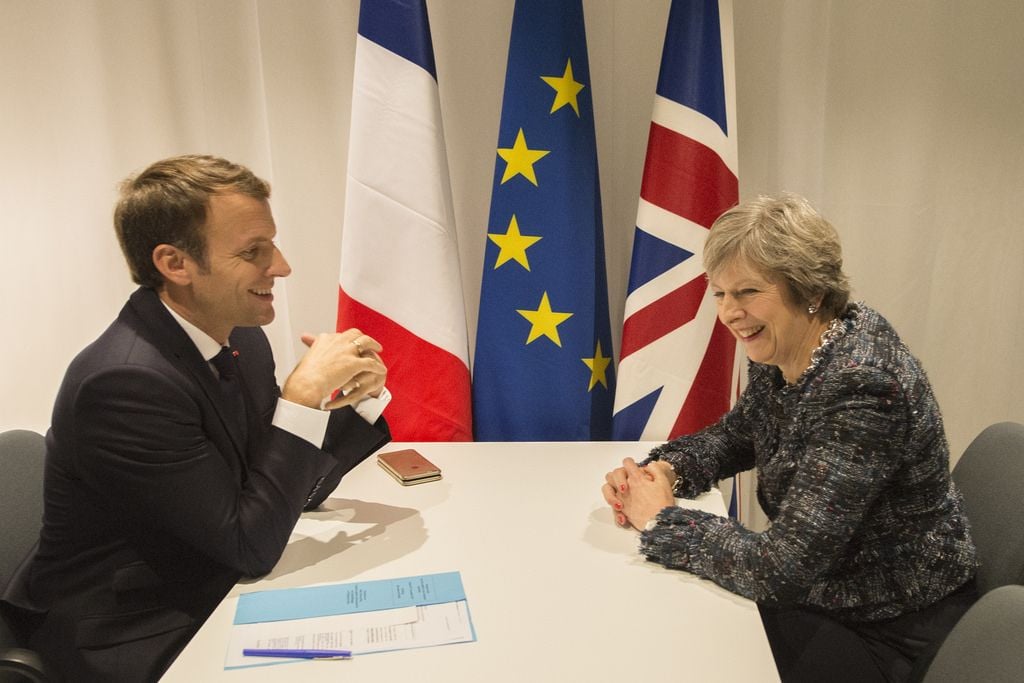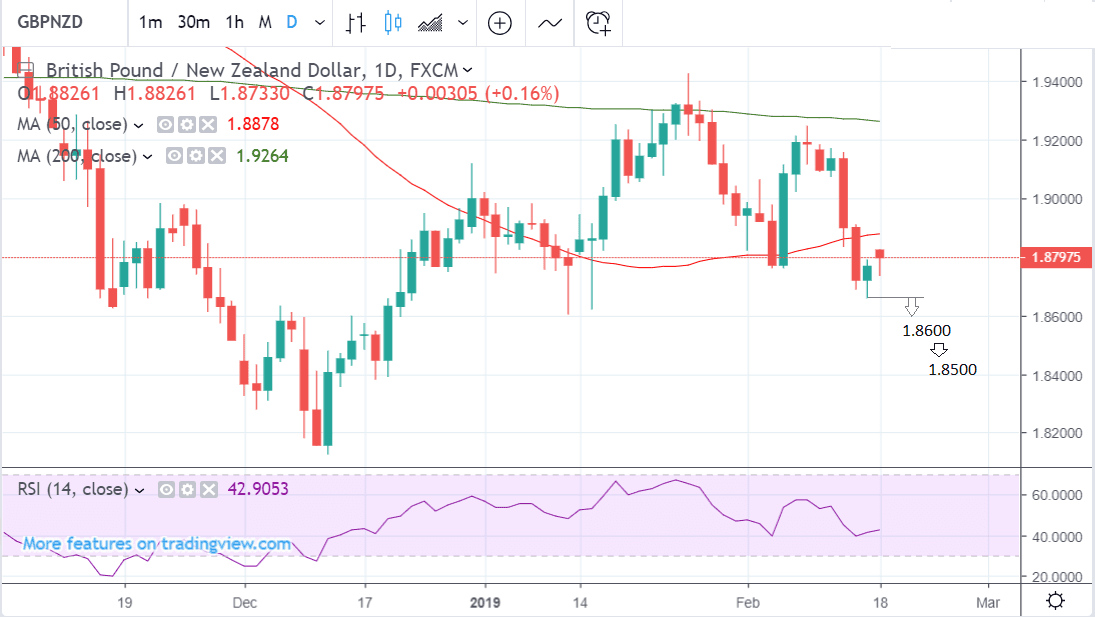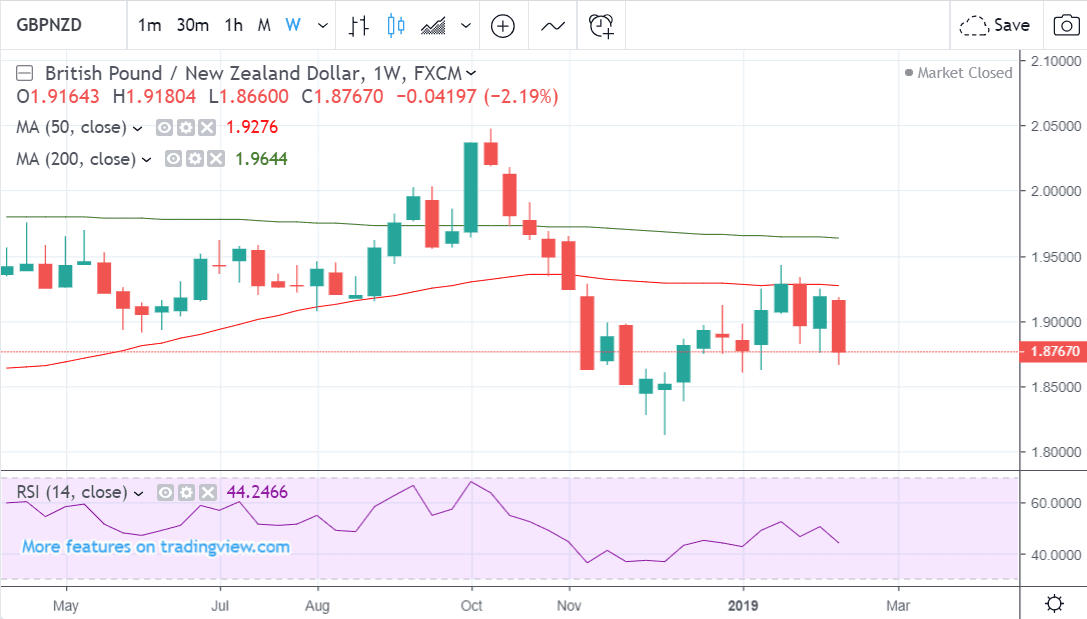Pound-to-New Zealand Dollar Rate in the Week Ahead: Downside Momentum Builds

Image © Naru Edom, Adobe Stock
- GBP/NZD in new possible downtrend after 1.67 break
- NZD rises in hope of delay of U.S. trade tariffs
- Sterling eyes another busy week for Brexit
The Pound-to-New Zealand Dollar rate is trading at 1.8767 at the start of the new week over two percent lower than the week before.
A stronger New Zealand Dollar on a more optimistic central bank as well as a weaker Pound after the government lost its Brexit vote were the main fundamental catalysts.
The technical outlook for the pair is now bearish, ever since the break below the 1.87 level confirmed the start of a new short-term downtrend, as we advised in our previous week’s forecast, in which we said that a break below that level would probably lead to a move down to a target at 1.86.
We now see it as likely the pair will achieve that target and if it breaks below 1.8590 it is also likely to move lower to a second target at 1.8500. These are both reachable within the coming week.
The pair broke cleanly below the 50-day moving average (MA) last week providing a strong bearish signal for the pair as this is usually the site of a price consolidation or bounce, except in cases where the trend is very strong.
The RSI momentum indicator on the chart is also suggesting bearish potential as it is now at a lower reading than when the January 1.86 lows formed, and at the same depressed level as when the market troughed on February 6. Overall this suggests bearish momentum in line with the forecast.
The weekly chart now also looks bearish after the pair ran up to and was rejected by the 50-week MA at 1.9276. The last week’s strong candle has altered the look and feel of the weekly chart which now looks a lot more bearish as a result and supports the outlook for more declines.
The New Zealand Dollar: What to Watch this Week
The New Zealand Dollar was supported in the previous week after the country's central bank surprised markets by dismissing the idea it might cut interest rates - a possibility widely entertained by market commentators.
Currencies are highly correlated to interest rates because they attract greater inflows when higher, so the move supported NZD (whilst resulting in a fall for GBP/NZD).
"At its first meeting for 2019, RBNZ downgraded its OCR projection and sounded slightly more dovish than November, which is exactly what we anticipated. However, some details were not so dovish," notes Imre Speizer, a foreign exchange strategist at Westpac in Auckland.
While the RBNZ struck an upbeat tone on the economy and is focussed on burgeoning capacity pressures Speizer say some of the RBNZ’s analysis appears out of date, and there may be a further dovish tilt once the latest information is incorporated.
Westpac are of the opinion the recent bump to the NZD from the OCR is therefore unlikely to last.
Westpac are awaiting New Zealand's Q4 GDP release which should be much lower than the RBNZ has forecast, and probably return market pricing to ~ 90% chance of a rate cut (from 50% currently). This should trigger a reversal in fortunes for the currency.
This release is however only due out on March 21, so markets have some time to wait. Instead, we believe global factors will be more of a driver for NZD over coming days.
Time to move your money? Get 3-5% more currency than your bank would offer by using the services of foreign exchange specialists at RationalFX. A specialist broker can deliver you an exchange rate closer to the real market rate, thereby saving you substantial quantities of currency. Find out more here.
* Advertisement
Of major significance to the New Zealand Dollar in the week ahead is the outlook for Chinese trade with the U.S. since the Kiwi is highly sensitive to trade flows with China, China being its largest trade neighbour.
At the moment the outlook is positive after President Trump hinted he would be extending the delay on implementing higher tariffs beyond the March 1 deadline, perhaps for a further 90-days. Such a delay if officially announced would be positive for the Kiwi.
On the domestic data front, meanwhile, the data released in the coming week is unlikely to move the currency very much.
First up is Services NZ PSI on Monday at 21.30 GMT.
The Global Dairy Trade Index is out at 15.00 on Tuesday; it showed dairy prices rising by 6.7% two weeks ago at the last auction and if the price increases continue the Kiwi might even gain a lift since dairy is its primary export sector.
New Zealand Produce Price data (PPI) is out at 21.45 on Tuesday. PPI is also known as factory gate inflation and measures the rise in prices of just produced factory goods. It is sometimes a leading indicator for broader inflation or CPI.
The Pound: What to Watch this Week

Image © Number 10 Downing Street
Brexit developments will likely be the primary driver for the Pound this week.
News out this weekend caught our eye: reports suggest French President Emmanuel Macron "and other European countries are ready to give Britain legally binding assurances that the Irish backstop is temporary".
"President Macron of France has softened his line in recent weeks to aid a last-ditch attempt by the EU to help get the withdrawal agreement across the line next month," says Bruno Waterfield, Brussels Editor at The Times.
"Macron to the Pound’s rescue," says Viraj Patel, foreign exchange strategist with Arkera. "We’re in the pessimistic-neutral state, so news like this will on the margin lift Sterling."
UK Prime Minister Theresa May is currently engaged in negotiations with the EU to win changes to the Irish backstop mechanism: that piece of the Brexit Withdrawal Agreement that could ultimately see the UK locked into the EU's single market and customs if ever triggered.
Legislators in the UK parliament in January rejected the Brexit deal and asked the Prime Minister to deliver substantial changes to the Irish backstop if they were to pass the deal.
For Sterling, the passing of a deal is seen as a best-case scenario as it eliminates a 'no deal' will simultaneously provides at least two years of legislative stability for UK and EU businesses.
Negotiations between the EU and UK are likely to continue this week with Prime Minister May due to meet European Commission President Jean-Claude Juncker over coming days.
Looking at the data calendar, the key release for the Pound will probably be employment and wage data out on Tuesday at 9.30 GMT.
The figures come out against a backdrop of falling inflation and broadly waning growth which have brought into question expectations that the Bank of England (BOE) will start raising interest rates as soon as the fog of uncertainty around Brexit has cleared.
“After the worrying GDP numbers for December, a weak set of jobs figures could spark more concerns that the never-ending Brexit saga is starting to have a more profound impact on the UK economy,” says Raffi Boyadijian, currency analyst at broker XM.com.
The unemployment rate remains at historic lows so the key market focus will shift to average weekly earnings in December. If these have increased to 3.5% year-on-year, as forecast, it could push up the Pound. Higher earnings would probably push up interest rate expectations and higher interest rates tend to have a supportive effect on the currency because they attract greater inflows of foreign capital.
“The jobless rate is predicted to have held at 4.0% in the three months to December, while average weekly earnings are forecast to have increased by 3.5 y/y during the same period, accelerating slightly from the prior 3.4%. Faster wage growth could be seen as offsetting some of the negative effects of lower oil prices on the consumer price index, which fell to 1.8% y/y in January,” says Boyadijian.
Another key data releases is the CBI Industrial Trends survey, which can provide a leading indicator for the economy. It is forecast to show a fall to -5 in February from -1 previously.
Public Sector Net Borrowing for the UK in January is out on Thursday at 9.30, and is followed by a speech from BOE’s chief economist Andy Haldane.
The CBI Distributive Trades survey in February is out at 11.00 on Thursday.
Time to move your money? Get 3-5% more currency than your bank would offer by using the services of foreign exchange specialists at RationalFX. A specialist broker can deliver you an exchange rate closer to the real market rate, thereby saving you substantial quantities of currency. Find out more here.
* Advertisement






